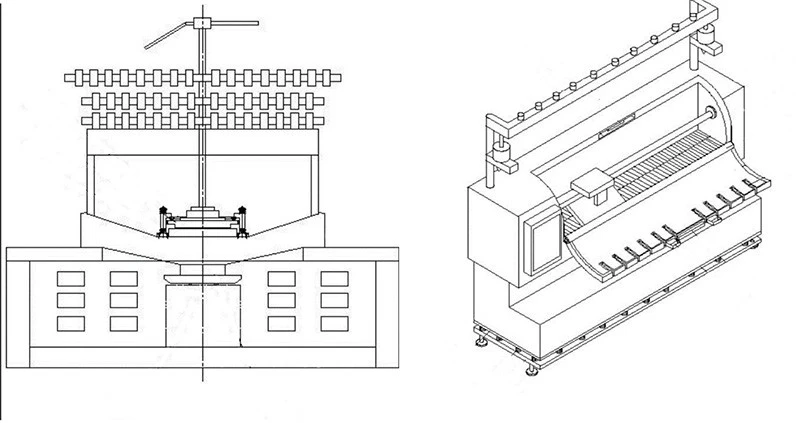Sự khác biệt giữa máy phẳng và máy tròn
Dec 18, 2023
In the realm of textile manufacturing, knitting machines play a crucial role in the efficient production of various fabrics. Among the various types of knitting machines, flat knitting machines and circular knitting machines stand out as the common choices for manufacturers worldwide. While both variants share the common goal of creating knitted fabrics, they exhibit significant differences in design, functionality, and applications. This article delves into the intricacies of flat knitting machines and circular knitting machines, exploring their fundamental distinctions and emphasizing their respective advantages and limitations.
Circular Knitting Machines:
As the name suggests, circular knitting machines operate in a continuous circular motion. These machines are specifically designed for the production of fabrics like T-shirts, jersey fabric, and sportswear. Unlike flat knitting machines that move needles horizontally and vertically, circular machines use a circular needle bed to transform yarn into a continuous tubular fabric.
Design and Functionality: Circular knitting machines consist of a cylinder, commonly referred to as the knitting head, containing numerous rows of needles arranged in a circular formation. Yarn is fed into the needles through sinkers and guides. As the cylinder rotates during knitting, it continues to form a tubular fabric.
Applications: Circular knitting machines excel in fabric production and are highly sought after for products such as T-shirts, leggings, sportswear, and similar apparel. They are also popular in the production of socks, hosiery, and various elastic fabrics.
Advantages:
- Tốc độ sản xuất cao: Máy dệt kim hình tròn được biết đến với khả năng sản xuất tốc độ cao của nó, lý tưởng cho sản xuất vải số lượng lớn.
- Overall Fabric Design: Due to the circular motion of large circular machines, they can easily produce extensive overall fabric designs.
Limitations:
- Các mẫu thiết kế hạn chế: Mặc dù máy tròn giỏi trong việc tạo ra các thiết kế tổng thể, chúng ít giỏi hơn trong các mẫu phức tạp, chi tiết.
- Yarn Consumption: Circular machines often consume more yarn compared to flat knitting machines, potentially increasing material costs and waste.

Flat Knitting Machines:
Máy phẳng được biết đến với tính linh hoạt và linh hoạt của nó, cho phép các nhà sản xuất tạo ra các mẫu và thiết kế phức tạp một cách dễ dàng. Các máy này hoạt động bằng cách cố định sợi trên một mặt phẳng, tạo thành các mảnh vải dệt kim phẳng thông qua các kim dệt di chuyển theo chiều ngang và chiều dọc.
Design and Functionality: Flat knitting machines typically consist of a needle bed, carriage, and guides. The needle bed features many narrow slots or grooves as the foundation for knitting needles. Each needle is manipulated through a cam system or computer control, allowing precise control over pattern formation. The carriage is responsible for horizontally moving the knitting needles across the bed, while guides accurately feed the yarn into the needles to form the fabric.
Ứng dụng: Tính linh hoạt của máy phẳng làm cho nó phù hợp cho một loạt các ứng dụng. Từ việc sản xuất những họa tiết và thiết kế phức tạp cho khăn choàng, áo len và váy cho đến việc tạo ra những bộ trang phục liền mạch, máy phẳng là sự lựa chọn phổ biến trong giới thời trang. Sự linh hoạt của chúng cũng làm cho chúng thích hợp để sản xuất nội thất, nội thất ô tô và hàng dệt gia đình.
Advantages:
- Design Flexibility: Flat knitting machines offer precise control over pattern formation, making them ideal for complex designs and patterns.
- Thân thiện với người dùng: Những máy này cung cấp hoạt động thân thiện với người dùng, làm cho nó có sẵn cho cả những người thợ thủ công lành nghề và người mới bắt đầu.
- Efficient Yarn Usage: Flat knitting machines maximize yarn utilization, minimizing material waste and potentially reducing production costs.
Limitations:
- Limited Width: The characteristics of flat knitting machines restrict the width of the fabric they produce, making them less suitable for extensive overall designs.
- Tốn thời gian: Làm các mảnh cắt vải lớn trên máy phẳng rất tốn thời gian, đặc biệt là khi so sánh với các phương pháp sản xuất vải khác.
Kết luận: Trong ngành sản xuất dệt may, cả máy phẳng và máy tròn đều đóng vai trò quan trọng. Sự lựa chọn giữa hai phụ thuộc phần lớn vào cấu trúc vải mong muốn, độ phức tạp của thiết kế và quy mô sản xuất. Máy phẳng cung cấp tính linh hoạt tuyệt vời cho các thiết kế và mẫu phức tạp, trong khi máy tròn làm chủ việc sản xuất vải ống liền mạch. Bằng cách hiểu được sự phức tạp và khác biệt giữa hai loại máy dệt kim này, các nhà sản xuất có thể đưa ra quyết định sáng suốt về việc đưa máy dệt kim phù hợp nhất vào quy trình sản xuất của họ và cuối cùng cung cấp hàng dệt chất lượng cao cho người tiêu dùng trên toàn thế giới.
next: Phân tích và giải pháp cho các khuyết tật phổ biến của vải dệt kim dọc
previous: Nguyên nhân và giải pháp của vải cong trong máy dệt kim tròn
